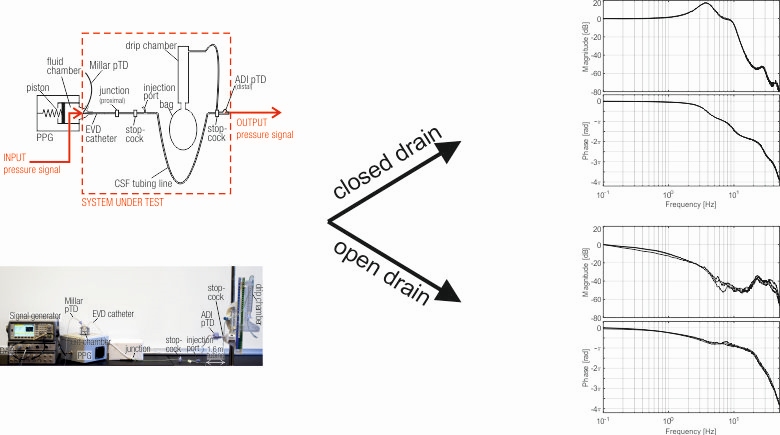
Whether analyzing the intra-beat or slow-wave oscillations in the intracranial pressure (ICP) waveform, any inference depends on faithful and consistent measurement of the underlying waveform.
The EVD-based pressure measurement occurs at the distal end of fluid filled elastic tubing that may itself act as a filter and distort the waveform. While the frequency response of arterial catheter systems has been studied extensively to understand their transfer function characteristics for detailed waveform analysis of the arterial blood pressure wavelet, the degree to which the EVD and associated drainage system distort the ICP waveform has not been investigated systematically, yet.
A laboratory setup was utilized that allowed to investigate the transfer characteristic of an EVD system by its step and frequency responses with particular focus on the low frequency range (important for diagnosis of the brain’s pressure autoregulation) and the location of the system’s first resonance frequency (important for estimation of the brain’s compliance). The effects of opening the distal end of the EVD for drainage of cerebrospinal fluid and the presence of trapped air bubbles are also investigated.
The key findings of this study were, that when using an EVD setup similar to one in this study, the first resonant frequency is very low and, hence, the ICP pulse waveform is distorted so that diagnosis made on basis of the ICP pulse waveform should be avoided and the estimation of the brain compliance is not recommendable as it is unpredictably misleading.
Estimation of pressure autoregulation remains uncorrupted as long as the drain is closed.
Once the transfer function of the EVD system is identified, the distorted ICP recording may be corrected by inverse modeling techniques. For this purpose, ICP correction by deconvolution in the frequency domain has been proposed and demonstrated in this study.

